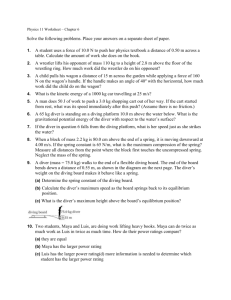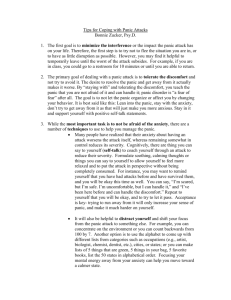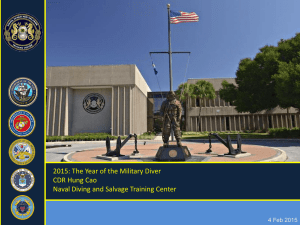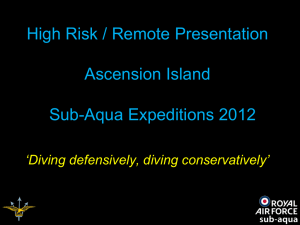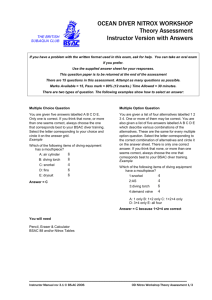Accident Management
advertisement
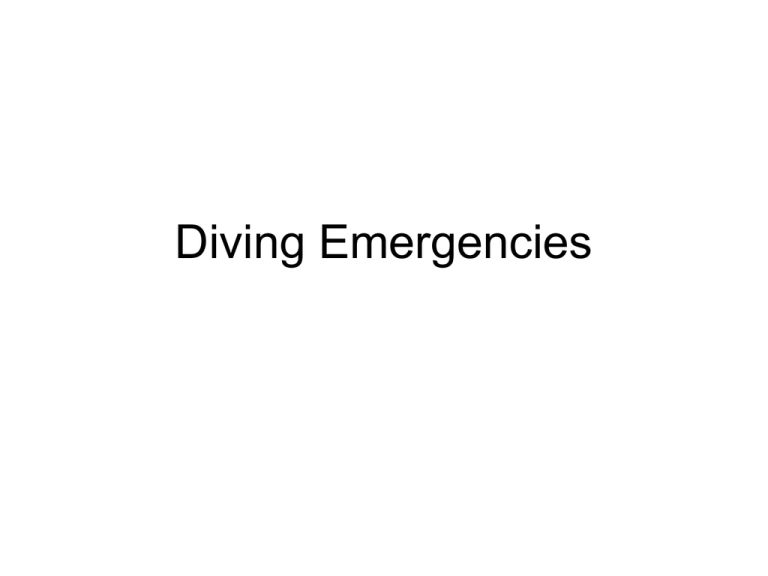
Diving Emergencies Main Topic Areas • • • • • Problem recognition Unsafe Diver behavior Stress Panic Accident Management Problem Recognition Learning Objectives • Identify the best time to begin evaluating yourself and your dive team for potential problems. • Best place and time to evaluate the team: Pre-dive during briefing and gear up. • Pre-dive warning signs: – Fixation with minor gear problems, – Idea fixation (sharks, depth, kelp, current, waves.) – Data collection fixation • In-water warning signs: – Mask off on surface – Jerky movements – Loose weight belt – BC inflated to the max – Treading high out of the water – Struggling to stay at the surface Early warning signs of diver stress or difficulty may be as subtle as an altered breathing pattern such as panting. Unsafe Diver Behavior Learning Objectives • Provide examples of unsafe behavior and discuss causes, recognition and prevention of each. Unsafe Diver Behavior • Poor diving techniques – Failure to check water prior to entry. – Diving with equipment problems. – Diving when unhealthy • Permanent contraindication • Temporary contraindication – Diving when physically unfit to dive • Temporary condition • Long term condition • Drugs and diving. – Street drugs. – Prescription drugs. – Over the counter drugs. – Decongestants Drowsiness – Pain killers Can't feel squeeze – Seasick Dehydration & drowsiness Stress and the Diver • Compare the two types of stress. • Describe the 3 primary factors which determine an individual's reaction to a stress situation. • Give examples of causes of stress and possible responses. • List and describe 7 steps in stress management. Physiological Stress • Undesirable interaction between the diver and the environment resulting from physical stimulus. stimulus rough conditions cold fatigue equipment response fatigue, motion sickness hypothermia, fatigue cramps, air starvation overexertion, hypothermia Unrecognized physiological stress can lead to psychological stress. Psychological Stress: • Undesirable emotional reaction to physical stress or to one's own beliefs and attitudes. • The stimulus can be real or imaginary. Either way, the end result is stress. • The severity of the reaction depends on the strength of the beliefs. Contributing Factors • • • • • • • • peer pressure ego travel inexperience (activity or site) long layoff gear discomfort (emotional, unfamiliar with gear) Environmental issues weak water skills Signs of Psychological Stress: • • • • • • • change in personality idea fixation pale or withdrawn nervous laughter irritable fixation with minor gear problems refuses to acknowledge any of the above Stress Management • • • • • Advance Visualization Anticipate and be prepared. Prevention: Observe and interact. ID and Solve Problems Give solutions not problems. Avoid negative words. Assist in Decision No undue encouragement or pressure. • Stop, Think, Act Have a plan ready to put into action! • Control Breathing Deep/Slow abdominal breathing has a calming effect on the diver as well as the rescuer. Panic • Studies show that panic has killed many divers even in cases where the stimulus was relatively minor. Panic Learning Objectives • Identify the causes and signs of panic . • Track the physiological development of panic. • Compare the two types of panic. • List and describe the three steps in panic prevention • Discuss techniques for controlling a panic situation. • Compare the responses of a stressed vs. a panicked diver. • • • • • • Causes of panic can be: environmental Physiological psychological one extremely stressful situation series of small stimuli may snowball. The onset of panic may be sudden or very gradual. Signs: The initial signs of may subtle such as altered breathing. • big eyes • jerky/thrashing movements • idea fixation • inappropriate responses – Active – passive • high treading • pale face Physiology of Panic: • adrenaline rush • panting • feeling increasing need to breathe • loss of buoyancy • fatigue leading to exhaustion • perceptual narrowing/tunnel vision • PANIC either active or passive Types of Panic Passive: The diver withdraws to the point of becoming catatonic and is unable to provide self-rescue. Active The diver goes crazy and may become physically uncontrollable. Prevention • Advance Visualization • control breathing • relaxation • dive within limits of training and experience Panic vs. Stress Panicked Diver: May be either completely unresponsive or likely to grab anyone or anything for support. Stressed Diver: May be capable of rational behavior and respond to simple commands, or may be unresponsive, or may grab anyone or anything. Control Techniques: • stop activity • control breathing • solve the problem • establish appropriate buoyancy • rest Accident Management • LEARNING OBJECTIVES: • Outline 7 steps in accident management. • Describe the primary concern when directing other rescue personnel. • List three areas of concern when contacting the local rescue agency. • Name at least one national agency which can give advice on diving accidents, and describe the proper procedure for contacting this agency. • List 5 precautions which should be taken in the event of a helicopter evacuation. Anticipate: • prevention: – assess divers &conditions, ID potential problems • preparation: – – – – med. history form emergency contact info evacuation plan equip. (be familiar with location and operation) • readiness – be ready to enter the water now!!!!! Assess: Stop,Think, Evaluate and form a plan. Act Implement the plan within the scope of training. Assign Tasks Do not endanger inexperienced divers! • establish a chain of command • phone callers • spotters • team of scuba divers follow the surface diver • I.D. victim and find buddy and personal effects • secure victims gear, rinse it, and hold for the authorities. Attend to Injuries • 1st Aid • CPR • 02 • treat for shock • Med. attention • No further harm! Administrate • Keep a record of what goes on. • Just the facts. Arrange Evacuation: • Opening statement establish scuba accident. • ID exact location. • Stay on the phone/radio until told to hang up. • Advise those involved that help is on the way. • Meet EMSS or mark area/boat so it is easily found. Don't assume that the local agency is familiar with dive injuries. It may be necessary to: • Advise of the need for 02 due to possible bends or embolism. • Where appropriate, advise of precautions regarding altitude. Helicopter evacuation: • Secure all loose objects. • Keep people clear of landing zone. • Maintain eye contact with pilot. – Never approach from the rear. • Allow basket or cable to ground itself to avoid shock from static electricity.
